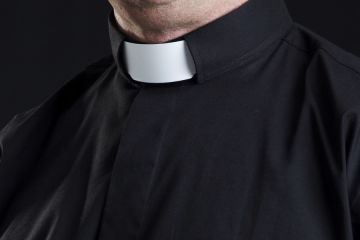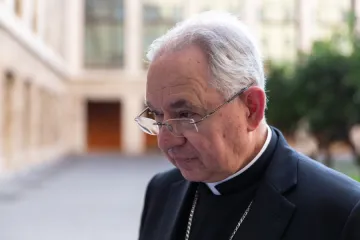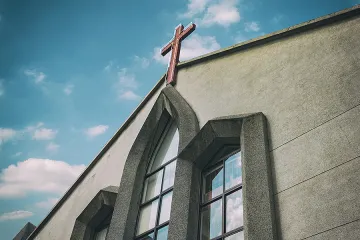Washington D.C., Nov 11, 2021 / 11:01 am
There are signs of progress in efforts to prevent sexual abuse of children, with under two dozen new allegations of recent abuse by clergy, according to the latest report on abuse in the Catholic Church in the U.S.
At the same time, over 4,200 new allegations of historic abuse were reported and about 35% of dioceses and eparchies lack a formal process to audit parishes for child protection practices.
The annual report on Findings and Recommendations on the Implementation of the Charter for the Protection of Children and Young People was released Nov. 9 by the U.S. bishops’ Secretariat for Child and Youth Protection. It is the eighteenth report since the charter was implemented in 2002.
The report concerns an audit year that runs from July 1, 2019 through June 30, 2020.
Suzanne Healey, chair of the National Review Board, said the audit identified 22 allegations of abuse occurring recently. In each case civil authorities were also notified of the allegation so that local law enforcement could address the problems as needed.
These cases represent 0.5% of all reports that the Church is aware of during the audit period.
“The fact that 4,228 allegations received were historical in nature (alleged victim is now an adult and the abuse happened in years or decades past) is also a reminder that the pain of the past remains and we as a Church must continue to reach out to all who have been harmed regardless of when the event occurred,” she said in a letter in the report.
“This year’s audit documents, once again, that new cases of sexual misconduct by priests involving minors are rare today in the Catholic Church in the United States,” U.S. bishops’ conference president Archbishop Jose Gomez of Los Angeles said in the preface to the report. “According to this latest audit, last year there were 22 current allegations nationwide involving minors; of these about one-quarter have been substantiated to date. Those offenders were removed from ministry. Every allegation was reported to law enforcement.”
“As we know, one allegation of abuse is too many,” said Gomez. “But my brother bishops and I remain firmly committed to maintain our vigilance in protecting children and vulnerable adults and providing compassion and outreach to victim-survivors of abuse.”
About 65% of dioceses or eparchies have a formal internal process to audit parishes for safe environment practices, but the remaining 35% are a matter of concern because of “the potential for abuse,” she said.
Healy said the review board aims to promote “the principles of high reliable organizations.” These principles, and parish audits, will “promote (the) safety of all and ensure that this tragic history is not repeated.”
The U.S. bishops’ conference president again apologized to abuse victims.
“On behalf of my brother bishops I again want to express our sorrow and apologies to every person who has suffered at the hands of someone in the Church,” Gomez said. “While we cannot give you back what has been taken from you, we do commit ourselves to doing everything in our power to help you to heal and to fight the scourge of abuse in the Church and in the wider society.”
Deacon Bernie Nojadera, executive director of the U.S. bishops’ Secretariat of Child and Youth Protection, said the pandemic might have had some effects on abuse reporting.
“Behavioral patterns changed, such as wearing face masks and frequent hand washing, and because everyone was home, the opportunity for children and those who were vulnerable to report instances of abuse became difficult,” he said in a letter included in the report.
At the same time, Nojadera said the report shows that charter abuse prevention measures are “working on a national level.”
(Story continues below)
“Though the Church’s efforts are admirable, constant vigilance is still required and the commitment of the clergy and lay faithful remains necessary,” he said. “The efforts of the Church will hopefully change the culture, and this will only work if everyone follows the rules.”
“The ministries of Safe Environments and Victim Assistance are here to stay,” he added. “The protocols and procedures for letters of suitability, background checks, and safe environment training are the norm. By the grace of God, the Church is working towards being accessible, accountable, and safe.”
Despite improvements in abuse prevention efforts, past instances of clergy abuse continue to be reported by victims.
Of the 4,250 new allegations against clergy tallied in the latest report, only 173 were considered unsubstantiated. 838 were substantiated, 991 were under investigation, and 825 were unable to be proven. Some 1,423 fell into another category, such as referral to a provincial, a diocese, or a compensation fund for evaluation. The allegations came from 3,924 adults and 22 minors.
In 2019, 4,434 total allegations were received, compared to 1,451 in 2018 and 693 in 2017.
The number of allegations reported in 2019 was “significantly high” due in part to some states’ changes in their statute of limitations, a trend that continued in 2020. Allegations were also received as a result of lawsuits, compensation programs, and bankruptcies, the report said. Colorado and Missouri released their own reports on sexual abuse by Catholic clergy last year.
“It should be noted that the vast majority of these reports were historical in nature,” said the report. Statistical graphs of the dates of reported abuse incidents continue to show a bell curve that peaks in the 1970s.
The Rochester, New York-based consulting firm StoneBridge Business Partners conducted the audit. The Center for Applied Research in the Apostolate conducted a survey included in the report.
Healey, the National Review Board chair, said the board was able to be effective in its work amid the “extreme crisis and turmoil” of the pandemic only because of God’s grace.
The audit process moved to a virtual format “but the essence of the audit remained unchanged,” said Healey. The report noted that chanceries and parishes were closed to help mitigate the spread of coronavirus, background checks were interrupted, staff turnover and reduced staffing levels worsened, and safe environment training of children and adults was at times suspended. At the same time, new methods of child protection training came to be used.
Total costs to dioceses and eparchies increased by about $33 million, including some $19 million in settlements and $14 million in attorneys’ fees. Since 2014, total costs are close to $312 million.
In the year ending June 30, 2020, some 2,771 clergy were accused. Of these, 2,458 were priests and 1,900 of these were diocesan priests. Among all priests accused that year, 87 were in active ministry. Of the accused, 1,501 had died, 264 had been permanently removed from ministry, 158 had been dismissed from the clerical state, and 75 had been temporarily removed from ministry. Fifty-four had resigned, and 186 were categorized as “other,” including retirees.
Almost all of the 33,469 Catholic clergy tallied in the report had gone through child protection training and background checks. Child protection training rates ranged from 98-99% among the 6,662 candidates for ordination, the 164,279 educators, and over 2.1 million volunteers at Catholic institutions.
The National Review Board’s Research and Trends Committee is evaluating safe environment education programs for adults and youth “to determine which elements or combination of elements of these training programs is most effective in mitigating the occurrence of child abuse,” Healey said.
Nojadera said safe environment trainings focus on child sexual abuse, but also have ramifications for combatting elder abuse, financial malfeasance, human trafficking, bullying, sexual harassment, boundary violations, and abuse of power. He said there is continuing need to help communities develop their awareness “to protect those who are vulnerable.”
According to the report, 57 of the 61 dioceses and eparchies audited were found to be compliant. The Diocese of Fort Worth and the Diocese of Helena took actions to remedy this, calling meetings of their diocesan review boards.
Pat Svacina, communications director for the Forth Worth diocese, explained to CNA Nov. 12 that the death of the diocese's safe environment director days before a scheduled meeting, and the onset of COVID "very shortly" after the hiring of a new director "precluded the board from being able to meet" during the audit year.
He added that the bishop "called a board meeting as soon as was physically possible which was August 6, 2020 ... Meetings were regularly held before, and they have been held regularly since," and that "Bishop Olson and the Diocese are strongly committed to providing a safe environment with strong training requirements as well as immediate action when allegations of clergy sexual abuse arise. This commitment includes following the requirements of the Dallas Charter."
The Ukrainian Catholic Eparchy of St. Nicholas of Chicago and the Syriac Catholic Our Lady of Deliverance of Newark Eparchy both failed to comply with two charter articles: one requiring safe environment training for youth and adults, and another requiring background checks for all clergy and adults working with minors. The eparchies’ bishops received clear assessments and recommendations to fix these shortcomings.
Last year’s report included a warning against complacency from Francesco C. Cesareo, then-chairman of the National Review Board.
“We continue to see the failure to publish reporting procedures in the various languages in which the liturgy is celebrated; poor recordkeeping of background checks; dysfunctional Diocesan Review Boards; lack of a formal monitoring plan for priests who have been removed from ministry; failure to update policies and procedures in light of the 2011 Charter revisions,” he said.
Cesareo said recurring problems are evident in 25 to 35% of dioceses, and this lack of diligence “puts children’s safety at risk.”
Editor's note 2021 Nov. 12 1255 MST: This article has been updated to include a statement from the Diocese of Fort Worth regarding the meetings of its diocesan review board.






